1. Becoming aware there is a Path (and watching for it)
2. Stumbling upon the Path and becoming aware of when one is on (or off) it
3. Understanding one was always on the Path
4. Realizing the Path does not come from or go anywhere has no beginning and no end
Author Archives: Steve Mays
Mark Cuban and AudioNet
The following is an excerpt from Learfield and the Internet: 1995-2005
In September of 1995 we received a phone call from Mark Cuban. He and a partner (Todd Wagner) had recently acquired a company called Cameron Audio Networks, named after its founder Cameron Christopher Jaeb. The company had acquired rights to broadcast radio and professional sports games live on the Internet. Cuban wanted to listen to the basketball games of his alma mater, Indiana University. Learfield owned the media rights to IU (and eight other universities and colleges). Cuban renamed his company AudioNet.
From the AudioNet media kit, October 1995:
“AudioNet is one of the most popular destinations on the Internet. People around the world know that when they want their choice of realtime and on demand audio programming there is only one place to go, WWW.Audionet.Com, the world’s first Broadcast Network on the Internet!”
“We offer them realtime broadcasts of radio stations such as KLIF Dallas, KFI Los Angeles, KOA Denver, XTRA San Diego, WQAM Miami, WJFK Washington DC WCKY Cincinnati, with many more to come. The there is the realtime broadcasts of exciting sporting events such as Texas A&M, University of Southern California, Baylor, Southern Methodist University college football, a growing schedule of professional football, baseball, basketball ad hockey, and Indoor Soccer.”
“In addition to sports programming we offer a complete choice of entertaining programming (you) can’t get anywhere else, like the Janice Malone Show, The Mark Cuban Show, Jeffrey Lyons Movie Reviews and Hollywood Reports, Medical Matters, Tech Talk, NetRadio, Geek Free Radio, Legal Matters, NetRadio, Celebrity Interviews with Michelle Pfeiffer, Patrick Swayze, Dustin Hoffman, George Foreman, Gennifer Flowers and much more. What’s even more exciting is that AudioNet is doubling (its) content offerings every month, with new things being added every day. Listeners know to stop by and see what’s new, and they do!”
On November 10, 1995, we met with Mark in Kansas City to discuss how our two companies might work together. It was Clyde, Allen Hammock, Steve Mays and (maybe) Chief Engineer Charlie Peters.
Since Learfield owned the broadcast rights, we couldn’t see the value of what AudioNet brought to the table. At one point Mark walked over to the whiteboard and scrawled some numbers, offering to sell 10% of his new company to Learfield for half a million dollars (others recall the number as one million). Learfield didn’t have the money at the time and really couldn’t see the value of AudioNet in any event. (Cuban sold his company to Yahoo! on April 1, 1999 for $5.7 billion, making it the most expensive acquisition Yahoo! had made at the time.)
In December, 1995, Learfield and AudioNet signed a letter of agreement for Internet distribution of our live college sports programming. AudioNet provided a minimum of 10,000 RealAudio streams while Learfield provided audio of our football and basketball broadcasts. We were also responsible for development of all content for the websites. Any advertising sold by Learfield, the split was 80/20 (80% to Learfield). If AudioNet sold the ads, the split was 60/40 (60% to Learfield). The term of the agreement was two years.
At some point during our talks with Mark, someone at Learfield asked why we couldn’t just do this on our own. Why did we need AudioNet? I recall Mark explaining he had an arrangement with RealAudio for streaming licenses that no other company could get. That was his edge.
Tweeting the execution
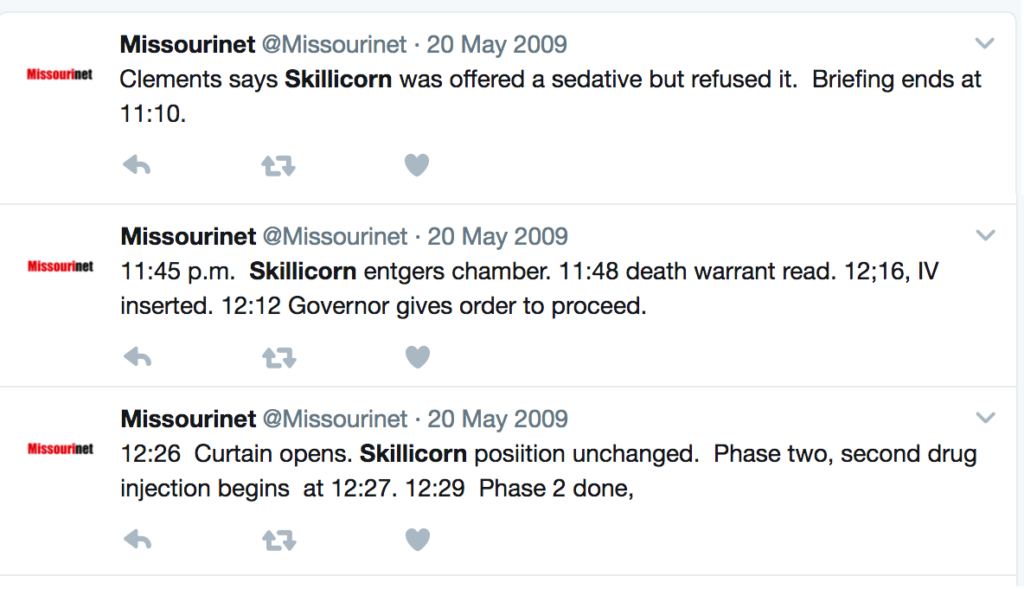
My Small History of Learfield and the Internet is nearing completion. Every drawer I open has some interesting new tidbit. Missourinet News Director Bob Priddy (now retired) share’s this gruesome bit of history:
“One of the highlights of our coverage of executions was when I became ( I think) the first reporter in the world who tweeted an execution. Dennis Skillicorn was executed in May, 2009. I could not take anything into the witness room except my notebook and a pen, and the book I had been reading in the waiting room, but I kept a careful chronology and as soon as we came out, I posted tweets on a minute-by-minute basis describing the events.
I stopped using Twitter in November of 2016 because it had become toxic with politics. Might return someday, might not. But searching for these Tweets reminds me of it’s historical importance.
ObitsOnline
I’m in the middle of another Small Histories” project. “Learfield and the Internet” is the working title. I’ll share it here when it’s as done as I can do it. But here’s a sample of the kinds of stuff we slung against the wall. ObitsOnline.
I knew from my small market radio days that people loved obituaries. Every morning the local funeral homes would call in details of funerals and visitations and we’d read them on the air. We tried to kill the feature once but people went ape shit.
The great thing about the early days of the Internet was nobody knew what might work so you could try anything. Why not let funeral homes throughout the state (Missouri) log in to an online database and post funeral announcements. The public could search by name, date, city, etc etc. We pitched the funeral home associations in Missouri and Iowa (maybe some other states, I don’t recall). Here are some screenshots:
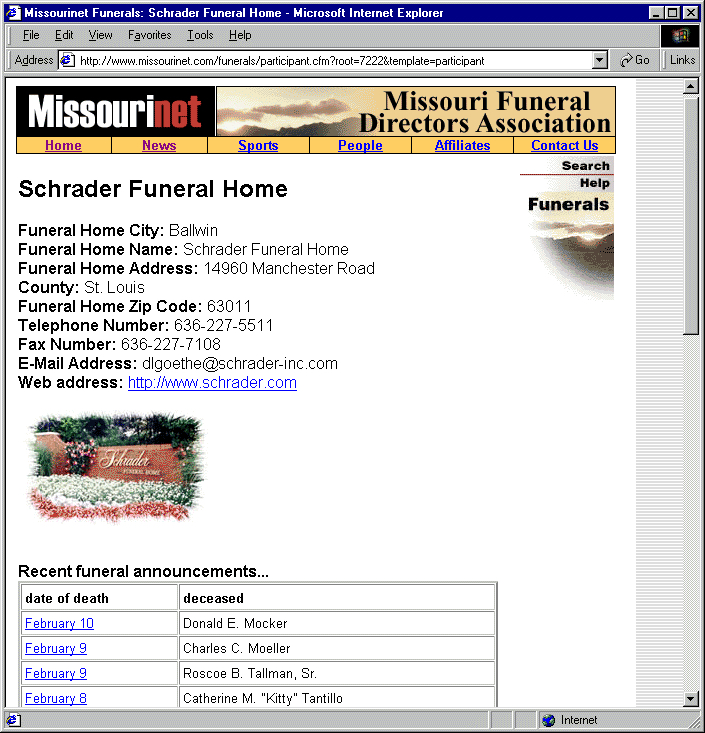
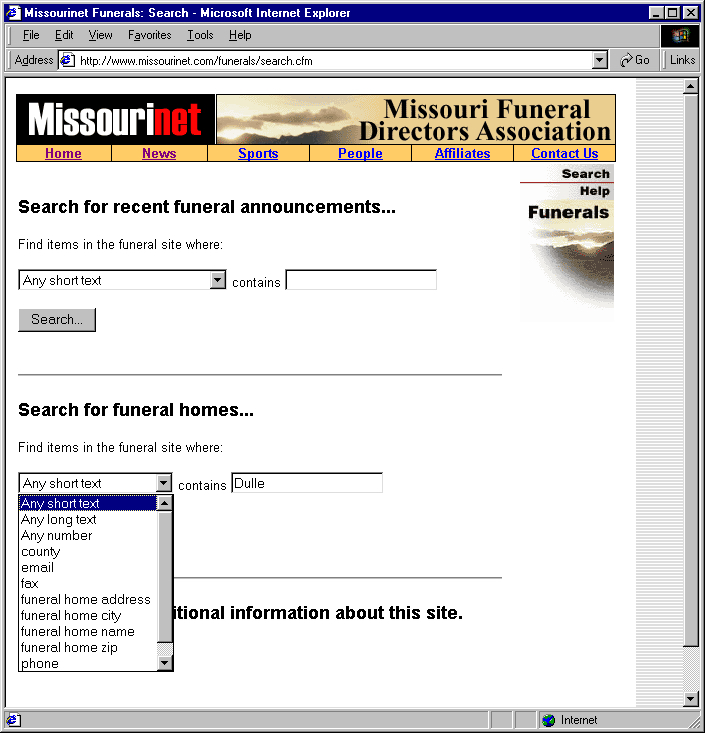
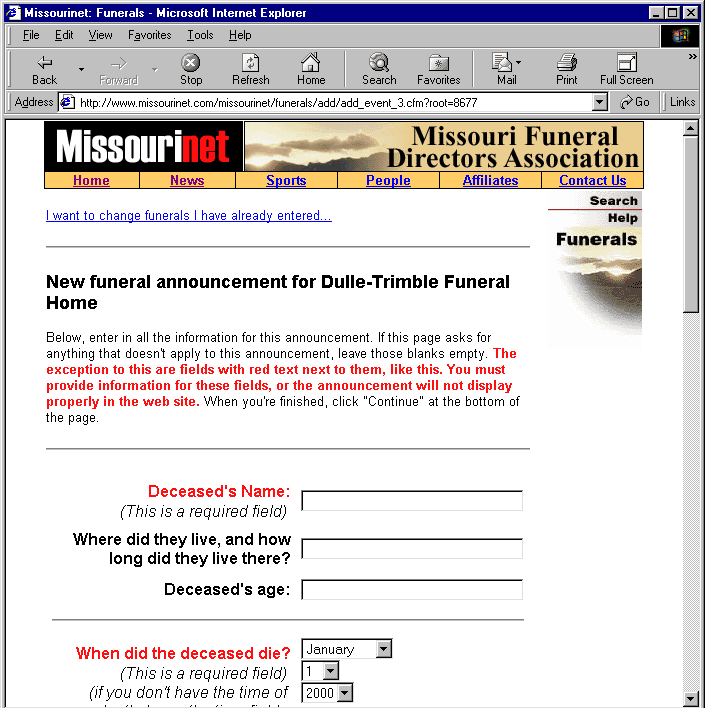
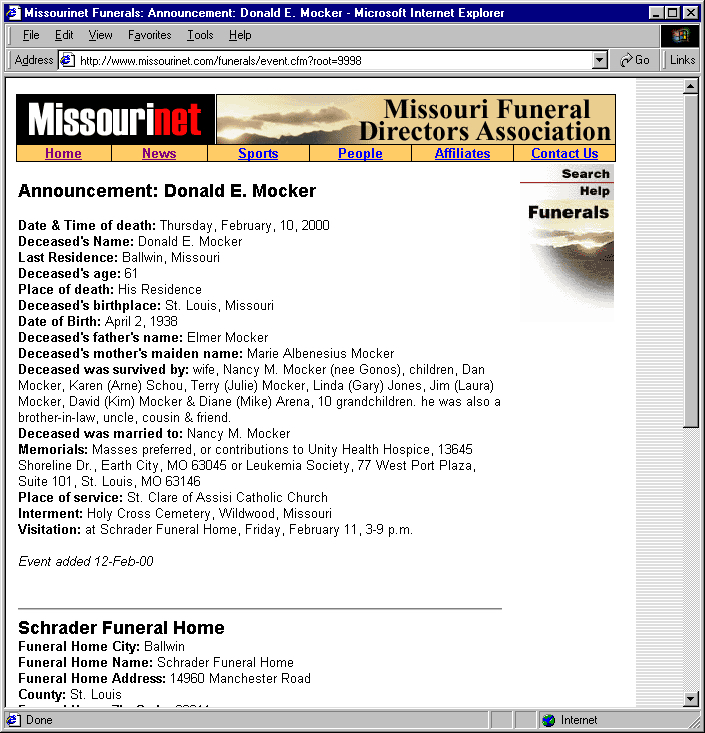
The idea never got off the ground because in 2000 most funeral homes were still trying to figure out their fax machines and were convinced the people in their communities were not using computers and were unlikely to do so any time soon. I have no idea what the business model for this might have been. In those days we were thinking more about what would be cool or interesting.
William Gibson Reimagines World After 2016 Election
“Agency,” Mr. Gibson’s next novel, which Berkley will publish in January. The story unfolds in two timelines: San Francisco in 2017, in an alternate time track where Hillary Clinton won the election and Mr. Trump’s political ambitions were thwarted, and London in the 22nd century, after decades of cataclysmic events have killed 80 percent of humanity. In the present-day San Francisco setting, a shadowy start-up hires a young woman named Verity to test a new product: a “cross-platform personal avatar” that was developed by the military as a form of artificial intelligence. Meanwhile, characters in the distant future are interfering with the events unfolding in 2017, through technological time travel that allows them to send digital communications to the past.”
New York Times book review »
Echo Look: Hands-Free Camera and Style Assistant
“Using just your voice, easily take full-length photos and short videos with a hands-free camera that includes built-in LED lighting, depth-sensing camera, and computer vision-based background blur. See yourself from every angle with the companion app. Build a personal lookbook and share your photos. Get a second opinion on which outfit looks best with Style Check, a new service that combines machine learning algorithms with advice from fashion specialists. Over time, these decisions get smarter through your feedback and input from our team of experienced fashion specialists.”
Wikitribune
I’m a big fan of Wikipedia. Whenever Jimmy Wales puts up one of those “we need your support” banners, I pitch in. Tomorrow (?) he’s launching a new project called Wikitribune.
“…a new online publication which will aim to fight fake news by pairing professional journalists with an army of volunteer community contributors. Wikitribune plans to pay for the reporters by raising money from a crowdfunding campaign. Wales intends to cover general issues, such as US and UK politics, through to specialist science and technology.”
Is that ‘through to specialist science and technology’ a typo?
“Those who donate will become supporters, who in turn will have a say in which subjects and story threads the site focuses on. And Wales intends that the community of readers will fact-check and subedit published articles. Like Wikipedia, Wales’s new project will be free to access. The publication is launching on Tuesday 25 April with a crowdfunding campaign pre-selling monthly “support packages” to fund the initial journalists.”
I’m not clear on how this effort will combat ‘fake news’ but don’t much care. People who shriek ‘fake news’ whenever they hear a story they don’t agree with have lost all credibility with me. I’ll be down for a monthly ‘support package.’
The story says journalists will “share full transcripts, video and audio of interviews.” Is there any news organization that routinely does this? If not, I wonder why.
UPDATE (9:20 a.m.) April 25, 2017 — I chose the $120 annually support option. If they don’t reach their goal (enough to hire 10 journalists) in 30 days, I get my money back. As of this writing they had 1,827 supporters, enough to hire one reporter.
Mic Flags

I first wrote about mic flags (“tiny little billboards”) in 2006. The photo above appeared in a Time Magazine article (1996) about the presidential campaign in Iowa. The hand belongs to Radio Iowa Reporter (now News Director) O. Kay Henderson. I recently came across the photo and wanted to put it somewhere easy to find again.
Swedish-based artist Simon Stålenhag

I love the work of Swedish-based artist Simon Stålenhag. I’ve shared some of his stuff here before. This one brings to mind the apartment building for the 21st century. Would love to know what inspired the artist.
“sT. aNNS” by Aaron Groen
 “Aaron J. Groen is an artist specializing in astro and landscape photography. He was born and raised in South Dakota and spent his entire life exploring the beauty and wonder of the midwest. Traveling the back roads and gravels where most people do not travel. Constantly in search of that next spot to shoot that perfect moment in time. Aaron loves South Dakota’s amazing night skies and things that seem to be left behind by mankind. You can see much more of Aaron’s photography on his Flickr site.”
“Aaron J. Groen is an artist specializing in astro and landscape photography. He was born and raised in South Dakota and spent his entire life exploring the beauty and wonder of the midwest. Traveling the back roads and gravels where most people do not travel. Constantly in search of that next spot to shoot that perfect moment in time. Aaron loves South Dakota’s amazing night skies and things that seem to be left behind by mankind. You can see much more of Aaron’s photography on his Flickr site.”
Hat tip to Margaret — tumblr junkie, art & photography lover, admirer of good coffee, two boxers dog owner, wife and mother.
